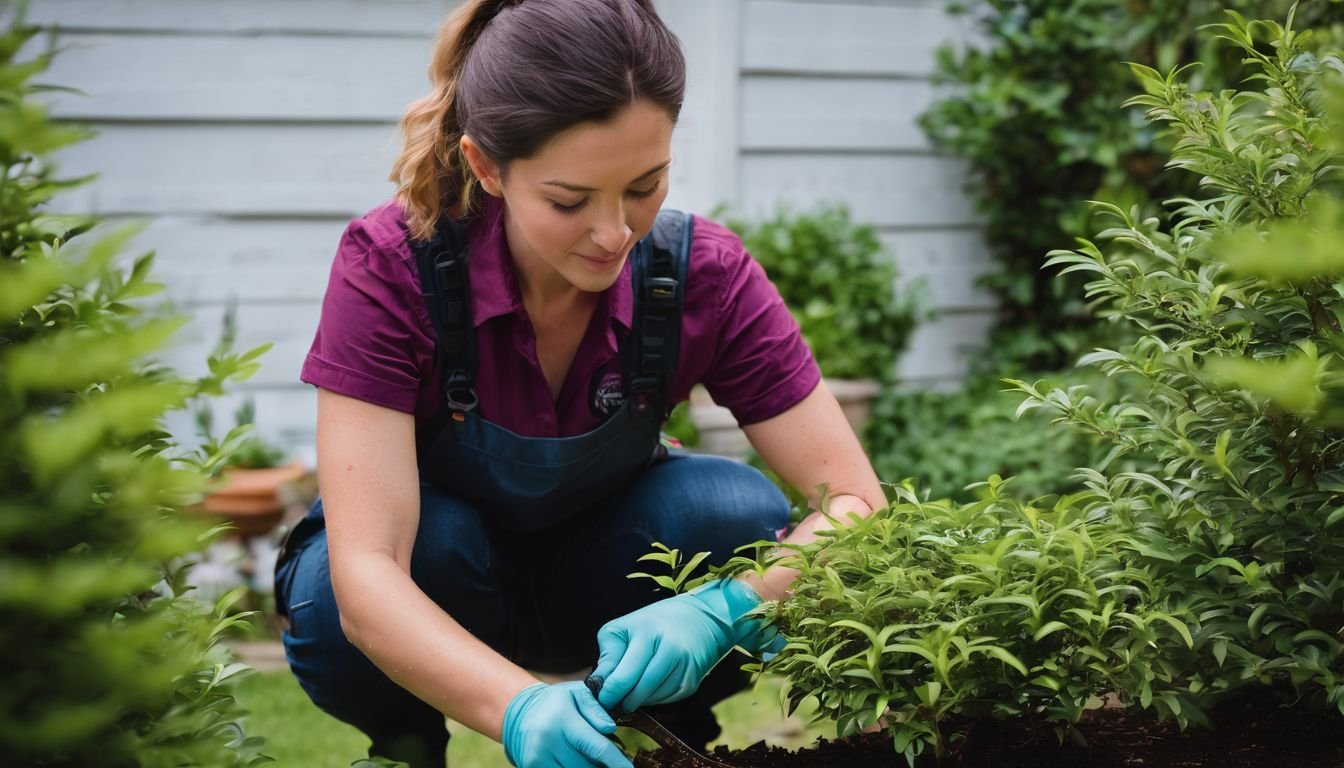Crafting a standout garden isn’t always a walk in the park, especially with Australia’s wide-ranging climate. Many Aussie gardeners find themselves at a bit of a crossroads trying to pick the perfect plant that not only survives our weather but also brings a bit of pizzazz to their green spaces.
We know the drill all too well; hunting down that ideal low-fuss yet eye-catching option can be quite the mission. However, after plenty of digging around and hands-on experience, we’ve stumbled upon a real treasure: the Loropetalum Purple Pixie.
This beaut not only flaunts lush purple foliage paired with striking pink flowers but is also known for its versatility under various conditions, including its knack for handling frost once it’s settled in—a crucial feature for flourishing in Aussie gardens.
Our guide delves into how you can successfully grow and care for your own Loropetalum Purple Pixie, covering everything from the best planting spots to regular upkeep advice. Whether you’re keen on filling out large areas or adding some depth to your rockeries and borders, this article’s got everything you need.
Let’s get cracking and give your garden that magic touch!
Key Takeaways
- Loropetalum Purple Pixie enjoys lots of sunlight but also needs some shade, especially during Australia’s intense afternoon sun. Finding the right spot that gets morning light and partial afternoon shade will help keep the leaves vibrant and support healthy blooming.
- This plant loves well – drained soil mixed with organic matter and prefers a slightly acidic to neutral pH level. Testing your garden’s soil before planting can guide you in making any necessary adjustments to ensure your Purple Pixie thrives.
- Regular watering is crucial initially, for about 12 weeks, to establish a strong root system. After that period, Loropetalum Purple Pixie becomes quite tough and can handle drier conditions, although maintaining consistent moisture will keep it looking its best.
- Pruning every few years encourages compact growth and helps maintain shape while ensuring the plant keeps its vibrant appearance. Always use clean cutting tools to prevent diseases from spreading.
- Keep an eye out for common problems like root rot or pests such as scale insects. Improving drainage can prevent waterlogged roots, while horticultural oils or insecticidal soaps effectively combat pest issues without harsh chemicals.
Growing Conditions for Loropetalum Purple Pixie

Loropetalum Purple Pixie thrives in Australian gardens, adapting beautifully to our diverse climate. It demands specific conditions to showcase its rich purple foliage and showy pink flowers, making it a stunning addition to any garden bed or as a dwarf ground cover for mass planting.
Ideal sunlight exposure
We need to find the perfect spot in our Australian gardens for our Loropetalum Purple Pixie. It thrives best when planted in well-drained soil, getting full sun to part shade throughout the day.
This range of sunlight exposure ensures that its rich purple foliage stays vibrant and supports the blooming of its showy pink flowers.
Choosing a location that receives morning sunlight but is partly shaded during the harsh afternoon can protect it from scorching. In areas with extreme summer heat, a bit more shade will help keep the plant healthy without sacrificing the colour or bloom quality.
It’s all about finding that sweet spot in your garden beds or as a dwarf ground cover where it receives just enough light to flourish but not too much to cause stress.
Making sure our Loropetalum Purple Pixie gets this ideal mix of light conditions sets us on the right path toward enjoying mass planting success and a stunning display of colour and texture in our gardens.
Preferred soil type
Loropetalum Purple Pixie thrives in well-drained soil, something we need to ensure for its optimal growth. It’s important to choose a spot in our gardens where water doesn’t stay standing after heavy rains.
Mixing in organic matter can improve drainage and aeration, making the soil environment ideal for these plants. This practice also aids in retaining the necessary moisture during dryer periods.
We must also consider the pH level of the soil; Loropetalum prefers slightly acidic to neutral soils. Testing our garden’s soil pH can guide us on whether adjustments are needed by adding elements like sulfur or lime, depending on the test results.
Incorporating slow release fertiliser at planting time gives them a great start by slowly feeding them over time without overwhelming their roots.
As we move forward with preparing our garden for Loropetalum Purple Pixie, let’s not forget about addressing sunlight exposure next.
Caring for Loropetalum Purple Pixie

Keeping your Loropetalum Purple Pixie in top shape requires a bit of know-how and dedication. We’ll guide you through the essentials, ensuring that this beautiful shrub remains a vibrant highlight in your Australian garden.
Watering requirements
We need to give our Loropetalum Purple Pixie regular drinks of water until it feels at home in our gardens, which usually takes about 12 weeks. This period is crucial for establishing a strong root system that can later withstand more variable conditions, including dry spells.
We recommend watering the soil directly rather than overhead sprinkling to ensure that moisture reaches where it’s needed most.
After this initial phase, we’ll find that our Purple Pixie becomes quite resilient and can handle drier times without too much fuss. However, maintaining moist but well-draining soil will keep it happy and thriving.
It’s all about balancing consistent moisture without overdoing it – something we’ve become quite good at in managing various plants in Australian gardens. Let’s not forget to mulch around the base to help retain that precious moisture as we move on to pruning and maintenance strategies next.
Pruning and maintenance
Transitioning from how we water our Loropetalum Purple Pixie, let’s delve into another vital aspect of care – pruning and maintenance. Giving our plants the attention they need doesn’t just involve hydration but also regular grooming to ensure they thrive.
- Prune lightly every 3-4 years: This keeps our Loropetalum Purple Pixie looking its best. A gentle trim encourages compact growth, helping it maintain its shape and vibrant appearance.
- Use clean, sharp tools: Always opt for clean, sharp pruning shears or scissors. This practice prevents disease transmission and ensures clean cuts that heal quickly.
- Spring is prime time for fertilisation: Apply a slow-release fertiliser as the weather warms up. This boosts growth and flowering, providing our plant with the nutrients it needs after a long winter.
- Check for frost damage: Although our plant tolerates frost, occasional harsh winters can cause damage. Come spring, inspect your Loropetalum Purple Pixie for frostbite signs and prune away any affected areas gently.
- Regular mulching is key: Mulch retains soil moisture and regulates temperature. Applying a layer around the base twice a year supports healthy growth and reduces weed competition.
- Stay vigilant against pests: Keep an eye out for common garden pests. Early detection allows us to manage them before they harm the plant significantly.
Dealing with Common Loropetalum Purple Pixie Problems
Caring for Loropetalum Purple Pixie in Australian gardens brings its own set of challenges. From dealing with root rot to preventing legginess, we’ve got some tips and tricks to keep your plants healthy.
- Tackle root rot by ensuring proper drainage. We know this lovely plant hates sitting in waterlogged soil. Use a mix that promotes good drainage and be cautious not to overwater. If you’re dealing with heavy clay soil, consider incorporating organic matter to improve the texture and prevent water from pooling around the roots.
- Prevent fungal diseases by sticking to a watering schedule that allows the topsoil to dry out between waterings. Overwatering is a common mistake, but it can spell disaster for your Purple Pixie by creating an environment where fungi thrive. Always check the soil moisture before reaching for that hose.
- Fight off scale insects without resorting to harsh chemicals. These pests can sap the strength from your plants, but they’re no match for horticultural oil or insecticidal soap. Apply according to the product instructions, focussing on infested areas, and remember, early detection makes all the difference.
- Avoid pruning too heavily as it can severely impact flowering and overall vigor of your plant. Instead, opt for light trimming to maintain shape and encourage dense growth without sacrificing those gorgeous blooms.
- Address legginess by implementing regular pruning sessions throughout the growing season. This encourages a bushier growth habit and ensures your Loropetalum Purple Pixie remains compact and lush rather than sparse and stretched.
- Increase watering during extreme heat periods to counteract stress caused by high temperatures and dry conditions. While Loropetalum Purple Pixie is fairly resilient, prolonged heatwaves can take their toll requiring extra attention to hydration levels during these times.
Additional Resources for Australian Gardeners
We understand that navigating the world of gardening, especially with unique plants like Loropetalum Purple Pixie, requires a treasure trove of knowledge and possibly some extra help.
There are several valuable resources available for Australian gardeners looking to deepen their understanding or solve specific problems. Local gardening clubs offer a wealth of knowledge through shared experiences from fellow enthusiasts.
These clubs often host workshops, plant swaps, and expert talks that can introduce you to new ideas and solutions tailored to our Aussie climate.
Exploring online forums dedicated to Australian gardening provides an accessible platform where questions can be asked and answered by a community passionate about green thumbs. Websites like the Australian Native Plants Society (ANPSA) offer in-depth guides on numerous species including care instructions suitable for Australia’s unique conditions.
They cover essential topics from frost tolerance to humidity resistance – all critical in ensuring your Loropetalum Purple Pixie thrives. Furthermore, local nurseries not only sell tubestock plants such as Loropetalum Purple Pixie but also are invaluable sources of practical advice tailored to your local environment.
For those who prefer digital assistance, various gardening apps have emerged as handy tools for plant identification, care reminders, and even pest diagnosis. Combining these technological aids with traditional resources ensures you’re well-equipped to tackle any gardening challenge head-on while enjoying the beauty and satisfaction that comes with nurturing plants like Loropetalum Purple Pixie in your own backyard.
Conclusion: Thriving Loropetalum Purple Pixie in Australian Gardens
Caring for Loropetalum Purple Pixie turns any Australian garden into a vibrant display of colours and textures. With its low maintenance needs and stunning appearance, this plant ensures gardens look lively year-round.
Embrace the guidelines for sunlight exposure, soil preference, watering, and pruning to see your Purple Pixie flourish. Remember, a bit of attention goes a long way in nurturing these gorgeous plants.
Let’s make our gardens buzz with the beauty of Loropetalum Purple Pixie.
FAQs
1. What makes Loropetalum Purple Pixie ideal for Australian Gardens?
Loropetalum Purple Pixie thrives in Australia’s varied climates due to its impressive humidity tolerance. This perennial plant fits perfectly in gardens nationwide, providing a lush, colorful groundcover with minimal care.
2. How often should I water my Loropetalum Purple Pixie?
Water your Loropetalum Purple Pixie regularly to establish it during its first growing season. After that, it requires less watering but appreciate a drink during extended dry spells, reflecting their adaptability to Aussie conditions.
3. Can I use Loropetalum Purple Pixie for privacy in my garden?
Absolutely! While the Loropetalum Purple Pixie is mainly known for its vibrant foliage and flowers, when planted en masse or alongside taller perennials, they can contribute to creating private spaces within your garden without the need for traditional fencing.
4. What are the best practices for ensuring my Loropetalum Purple Pixie thrives?
To ensure your Loropetalum Purple Pixie flourishes:
– Plant in well-drained soil,
– Provide ample sunlight with some partial shade,
– Maintain regular watering routines especially in extreme heat,
– Apply mulch to keep roots cool and moist.
These steps will help your plant thrive and brighten up your garden space with its unique purple foliage and pink blooms.
